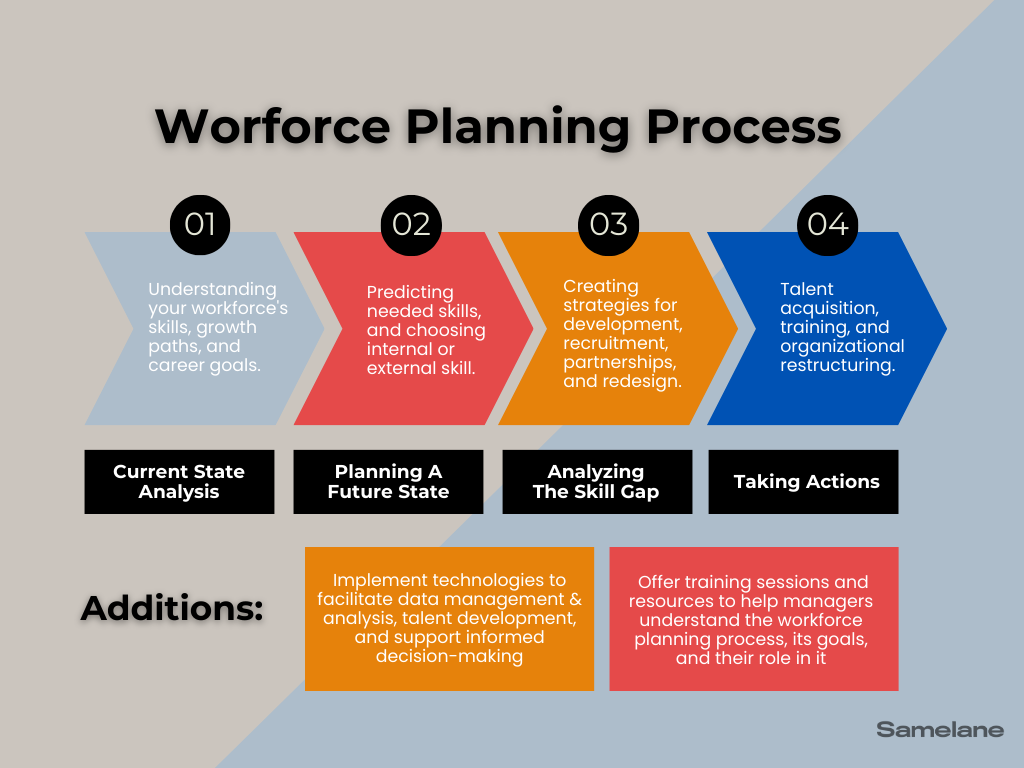As the global job market reshapes itself post-pandemic, organizations are actively implementing new employment strategies, including strategic workforce planning, to tackle the evolving landscape. 87% of companies acknowledge the talent gap as a challenge, so this strategy is crucial.
In the U.S., the situation is acute, with a 1.5 million worker labor gap four years post-pandemic, signaling a widespread talent shortage, especially in tech (1). Germany expects tech job vacancies to climb from 700,000 in 2023 to 780,000 by 2026 (2). Meanwhile, in North America, nearly 80% of laid-off tech workers in 2022 quickly found new jobs, highlighting a mismatch between tech job availability and a skilled workforce.
How To Understand A Talent Gap?
A talent gap is a noticeable disproportion between the demand for project management skills and the supply of capable talent. The talent gap is widely viewed as one of the greatest economic threats globally, as it undermines economic growth by stifling productivity and innovation due to a shortage of skilled workers.
The talent gap, or a skill gap, drives up wages and ramps up the talent competition, posing significant challenges for small businesses. It intensifies as rapid technological changes outpace educational systems’ ability to adapt, leading to higher unemployment and lower economic productivity.
What Is Workforce Planning?
Workforce planning is about matching your company’s staff with its business aims and objectives, often by adjusting the workforce size to fit the workload requirements.
Some sources provide an extensive definition of workforce planning. For example, it is understood as something that additionally identifies gaps and outlines targeted talent management actions to ensure that an organization possesses the correct individuals (3). It should also be equipped with the appropriate skills, in the optimal positions, precisely when needed, to fulfill its mission and strategic goals.
A strategic workforce planning is becoming one of the most fundamental processes for achieving success. In a situation of global talent shortages, it helps to use the opportunities and strengths of employees and manage their daily satisfaction. It is also a method that supports basic HR activities, such as employee retention and hiring.

How Can Workforce Planning Close the Talent Gap?
Research shows that strategic workforce plans can help close talent gaps in many ways:
- HR departments can use it to analyze current skills and identify where training or hiring is needed.
- The process includes succession planning to prepare internal candidates for critical roles, ensuring continuity.
- It also aims to attract suitable talent through customized recruitment and a flexible workforce, incorporating freelancers and remote workers.
- A well-thought-out workforce plan includes data analytics to support informed decision-making and the need for employee retention, diversity, and inclusion.
- In closing the talent gap, human resources divisions can also use continual review and adjustment of the strategy to ensure the plan meets present and future talent needs.
- As a whole, workforce plans aim to keep the organization equipped with the right skills.
A Workforce Planning Process. What Does It Look Like?
Planning for your workforce is a process that aims to ensure the right number and type of employees. This process includes analyzing and assessing employees’ work, thanks to which HR departments can define new roles, competencies, and ways of organizing. Moreover, strategic planning for human resources involves predicting future events and facts, which is why some people understand it as rationally analyzing the future.
The classic workforce planning process is very simple and consists of 4 stages: current state, future state, gap analysis, and action:
- Current State – Conducting a thorough audit of the existing workforce and evaluating skills, roles, and competencies.
- Future State – Strategically forecasting the organization’s workforce needs for the next 2-4 years, considering business evolution and market trends.
- Gap Analysis – Identifying and analyzing discrepancies between the current workforce and future requirements, and develop strategies to address these gaps.
- Action Plan – Executing strategies to align the workforce with anticipated future needs, including talent acquisition, training, and organizational restructuring.

How to Build A Workforce Planning Model?
As we progress from the foundational workforce planning scheme previously outlined, it’s important to delve into the specifics of crafting an effective workforce plan. So, let’s take a deeper look and build a workforce planning model:
Step 1: Make a In-Depth Current State Analysis
You need to look beyond basic headcount. This involves thoroughly understanding your current workforce’s skills, growth trajectories, and career aspirations. Recognize who is in your organization now, their future potential, and how they are developing. This insight is critical for your planning.
Step 2: Plan a Future State
Building on your initial analysis, your next task is envisioning your future workforce. This means predicting necessary skills, understanding the evolving organizational ecosystem, and deciding if these skills will be developed internally or sourced externally. You should accurately forecast talent demand and assess internal and external talent supplies.
Step 3: Analyze the Gap and Plan Some Scenarios
With a clear understanding of where your workforce currently stands and where it needs to be, your next step is to identify and analyze the gaps. This involves creating strategies for internal development, external recruitment, forming partnerships, and redesigning your organization.
Step 4: Take Action and Implement It
The final step of this workforce planning model is implementing your strategies. Remember, workforce plans are not static as they require continuous adaptation. You must monitor, measure, and communicate the effectiveness of your strategy consistently. Implementing robust governance is essential to manage this ongoing process.
How To Implement a Strategic Workforce Planning?
To implement your plan for your workforce effectively, it’s vital to consistently monitor progress and stay flexible to adapt to your business and market changes. Success hinges on fostering strong collaboration across departments, maintaining clear communication, and ensuring active employee engagement. These elements are key to smoothly executing your strategy.
Additionally, the integration of key technologies is imperative. Incorporating a Learning Management System (LMS) for skill development and leveraging advanced tools for data visualization are fundamental. Also, leveraging AI platforms can significantly enhance your ability to engage in predictive planning, further strengthening your workforce plans.
Additionally, refine resources by eliminating redundant roles and outsourcing non-core tasks. Optimize costs through automated routines, strategic long-term hiring, and efficient employee development using your Learning Management System (LMS). Consider adopting flexible workforce models like part-time or remote work to manage labor costs effectively.
A conclusion
An effective plan for your workforce is crucial for bridging the talent gap and driving business growth in today’s dynamic job market. Businesses can effectively navigate the challenges of a shifting landscape by focusing on a strategic approach that includes continuous monitoring, adaptability, and solid interdepartmental collaboration.
Integrating advanced technologies, particularly a robust LMS for large enterprises, is pivotal in skill development and workforce optimization. Additionally, refining resources by eliminating redundancies, outsourcing non-core tasks, and embracing flexible workforce models are key strategies for cost optimization. Ultimately, a well-executed workforce planning process closes the talent gap and positions organizations for sustained success and competitiveness in the global market.
(1) https://www2.deloitte.com/content/dam/Deloitte/us/Documents/consulting/us-meet-business-outcomes-by-evolving-to-strategic-workforce-planning.pdf
(2) https://www.mckinsey.com/capabilities/mckinsey-digital/our-insights/tech-forward/closing-the-tech-talent-gap-adopting-the-right-mindset
(3) https://hr.nih.gov/workforce/workforce-planning











